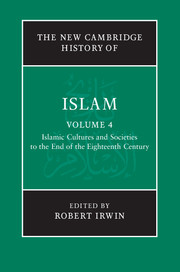Book contents
- Frontmatter
- Introduction
- PART I RELIGION AND LAW
- PART II SOCIETIES, POLITICS AND ECONOMICS
- PART III LITERATURE
- PART IV LEARNING, ARTS AND CULTURE
- 20 Education
- 21 Philosophy
- 22 The sciences in Islamic societies (750–1800)
- 23 Occult sciences and medicine
- 24 Literary and oral cultures
- 25 Islamic art and architecture
- 26 Music
- 27 Cookery
- Glossary
- Bibliography
- Index
- References
24 - Literary and oral cultures
from PART IV - LEARNING, ARTS AND CULTURE
Published online by Cambridge University Press: 28 March 2011
- Frontmatter
- Introduction
- PART I RELIGION AND LAW
- PART II SOCIETIES, POLITICS AND ECONOMICS
- PART III LITERATURE
- PART IV LEARNING, ARTS AND CULTURE
- 20 Education
- 21 Philosophy
- 22 The sciences in Islamic societies (750–1800)
- 23 Occult sciences and medicine
- 24 Literary and oral cultures
- 25 Islamic art and architecture
- 26 Music
- 27 Cookery
- Glossary
- Bibliography
- Index
- References
Summary
A most distinctive feature of Arabic is the coexistence of a relatively uniform written language, read by a great number of people from Morocco to Malaysia and by literate Muslims throughout the world, alongside several divergent and mutually unintelligible dialects, spoken in significant but smaller regions between the Atlantic coast of northern Africa and the Arabian Sea. Many individuals may speak a dialect at home while learning at school to read, write, speak and understand Modern Standard Arabic (Ar. fuḥ), an elevated language used for speeches, lectures, newspapers, literature and radio and television broadcasts throughout the Arab world. The coexistence of written and spoken forms of the language appears to be as old as Arabic itself, and has led to the emergence and perpetuation of distinct literary and oral cultures.
Like other Semitic languages Arabic relies on verbal roots, usually composed of three (sometimes four) phonemes. While some words are shared between the elevated language and the various colloquials, many differences in vocabulary and grammar distinguish them. The most important is syntax: the elevated language normally uses verb/subject/object word order, with grammatical function indicated by conjugated verbs and inflected nouns, whereas the colloquials normally use subject/verb/object word order and reduce conjugations and inflections to a minimum. In actual practice the regional dialects may blend into the literary language, yet fuḥ still remains virtually the only acceptable vehicle for written communication throughout the Arabic-speaking world.
- Type
- Chapter
- Information
- The New Cambridge History of Islam , pp. 668 - 681Publisher: Cambridge University PressPrint publication year: 2010



